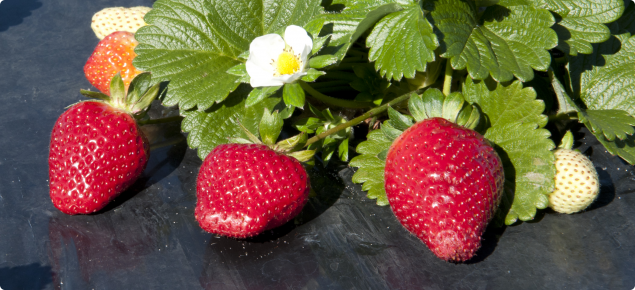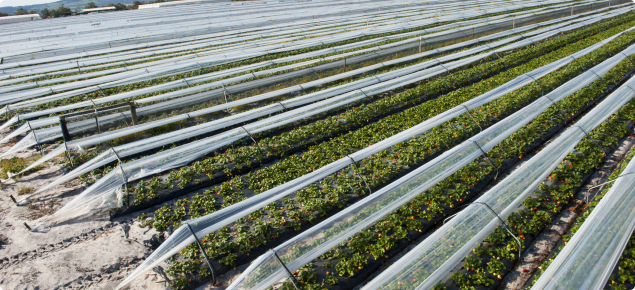Site selection
Strawberries are herbaceous plants, belonging to the family Rosaceae and are normally grown as an annual crop in Western Australia.
Almost any well drained soil will grow strawberries, although well drained loams with lots of organic matter are ideal. Strawberries grow best when soil pH is around 6.5, but will grow in the pH range 5.5 to 7.5.
A gentle slope with a northerly aspect will be beneficial for early season and winter cropping, but on colder, low lying properties the main season crop may be larger, and carry on later. Virgin land is preferred because pests, diseases and weeds are less troublesome.
Adequate water of excellent quality is required, as strawberries are very sensitive to salt damage. The salt content of water should be below 400mg/L (or about 75mS/m conductivity). A yield loss of 25% would be expected if water with 650mg/L (120mS/m) was used.
Roadside sales and pick-your-own harvesting can be profitable and may influence site choice. Most fruit is sold through the Canning Vale markets but some growers sell direct to supermarkets.
Large plantings should be near population centres, as labour for harvesting will be more readily available. Up to 40 people for three to four days a week may be needed to pick and pack a two hectare strawberry crop.
Land preparation
Eradicate all persistent weeds such as couch, kikuyu and sorrel either by repeated cultivation in dry conditions or by chemical means such as spraying with glyphosate during rapid growth. Deep plough and rotary-hoe the site several times to give a lump-free bed. Compost can be applied at this time and if pH correction is required this should be done using lime and/or dolomite. Use of raw poultry manure is banned around the Perth metropolitan area and in some other Shires on the Swan Coastal Plain, as it breeds stable fly.
Soil disinfestation
Most growers apply fumigant each year prior to planting. Current options include metham-sodium, usually applied broadacre if weeds are bad, prior to 1,3-dichloropropene application or Telone-C35™ applied using shank injection or Rural Inline™, applied through the irrigation. The latter two are usually applied after beds are formed. For inline fumigation to be effective the soil must be uniformly moist and compact and the irrigation system must be designed to apply water (and hence fumigant) evenly. If fumigation is uneven then pockets of disease may remain to reinfect the crop. Be sure to leave adequate time before planting so the chemical can dissipate. The rates of telone for strawberries are higher than for vegetables at 470-940kg/ha. Instructions on the label must be followed.
Where irrigation systems are poorly designed and apply water unevenly it is preferable to use shank injection rather than in-line application. On sands, lateral movement of water is very poor and even if emitters are applying water uniformly it is difficult to get even application of fumigant across the bed. Even using shank injection, tines need to be relatively close together, two tines for a one metre wide bed is not satisfactory in sands.
Since the major disease issue is for growers is fusarium crown rot a mixture of 1,3-dichloropropene and chloropicrin is better than straight 1,3-dichloropropene. Formulations with 35% chloropicrin are in common use but 60% may be better. With repeated use these fumigants become less effective.
Metham sodium is more effective for weed control. It may be wise to rotate fumigants to prolong their efficacy. Some growers fumigate twice, once with metham sodium and then again once beds are formed with 1,3-dichloropropene and chloropicrin.
Other alternatives may be soil solarisation, biofumigants such as mustards, or soil steaming. None of these are proven under Western Australian conditions, however fewer chemical fumigants are being developed and resistance to them is increasing. A combination of fumigation methods may be more durable in the long term unless growing out of the ground is a consideration; either in soil-less media or hydroponics.
All fumigant chemicals are highly toxic and must be applied according to the label. Read the label carefully and follow the instructions. Growers need to be licensed to buy and apply 1,3-dichloropropene and its formulations.
Bed formation and plastic laying
Strawberries are usually grown on raised beds covered with black polythene sheet. This provides the plant with deeper soil and good drainage. Black polythene controls weeds, warms the soil faster and promotes fast, early growth so the plants crop earlier. The fruit is kept clean and because berries are not in contact with soil, there is less rotting.
The soil should be moist before beds are formed. Tractor-drawn implements are available for bed forming and polythene laying. Laying the polythene sheeting when it is warm to hot or during the heat of the day assists in obtaining a firm, stretched appearance, reducing wind damage on new plants.
Beds are spaced according to planting density and at suitable distances for straddling by a tractor and other equipment. Four row beds are common in the Perth area and are usually 1.2m wide with 30cm wheel tracks. Some growers have beds only one metre wide for four rows and others use three or even two-row beds. There are arguments for and against all configurations. Two-row beds are good for speed of harvesting and for spray penetration but less plants can be grown per hectare.
The most commonly used polythene is about 1.7m wide and 25 to 50 microns thick. Slits or holes punched in the plastic aid water penetration. To avoid salt build-up, beds should be no more than 15cm high where sprinkler irrigation is used. With trickle irrigation, beds may be any suitable height. In Florida, 35cm is recommended, the philosophy being to keep all root material within the bed and above the height of the pathways.
Life of a planting
Most growers keep their strawberry plants for only one season, because fruit size falls in the second year and disease and management problems increase. Some growers cut plants back at the end of the first season to allow one early flush in about March of the following year.
Varieties
New varieties of strawberries are released every year. Widely planted varieties for the Perth region are Camarosa, Festival and Albion and for the south of the state, Albion and San Andreas.
Planting material
Strawberries can be affected by virus diseases which seriously reduce the vigour of the plants, resulting in lower yields. Certified strawberry runner schemes operate in Victoria and Queensland to supply virus-free planting material. Grower-members of these schemes produce planting material of acceptable standards under Government supervision. Growers should obtain certified planting material from these sources. Certified runners are available from Victoria and Queensland.
Runners should be ordered well in advance of requirements (generally a year ahead), since supplies can be short.
- Toolangi Certified Strawberry Runner Growers' Association
C/- Post Office
Toolangi Victoria 3777
Phone: +61 (0)3 5962 9220
Fax: +61 (0)3 5962 9416 - Perry Runners
PMB No 4
1826 Healesville-Kinglake Rd
Toolangi Vic 3777
Phone: +61 (0)3 5962 9429
Fax: +61 (0)3 5962 9428
e.s.kperry@bigpond.com - Sweets Strawberry Runners
846 Nundubbermere Road
Stanthorpe Queensland 4380
Phone: 07 4683 6209
office@sweetstrawberryrunners.com.au - Red Jewel Nursery
744 Emu Swamp Rd
Ballandean Qld 4382
Phone: Ian Mungall: +61 (0)427 584 655
Elise Pike: +61 (0)429 841 133
Office: +61 (0)7 4684 1133
Fax: +61 (0)7 4684 1186
Driscolls, who operate a closed loop marketing system using their own varieties, also have a network of growers in Australia.





